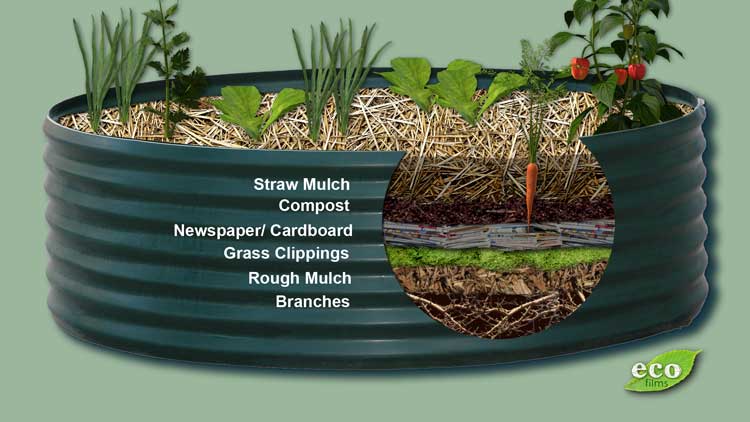Source: Eco Films
Recently when filming with Permaculture gardener Rosina Buckman, we asked her how she managed to grow her amazing vegetables in her raised bed gardens without importing a lot of expensive soil. These tanks were raised off the ground and faced a sunny spot right out at the front of her house. Rosina responded that we need to look and think about our garden beds the same way we approach a compost heap.
“All you have to do is think of it as a great big compost bin.” she said.
Rosina cleverly asks her neighbors to donate their pruning and discarded vegetable matter. Most people are only too happy to oblige to get rid of their stuff for free. Rosina first lays out the bulky stuff, palm fronds, tree branches and woody material as the base of her raised garden.
This bulky stuff will take the longest time to break down so it all sits at the bottom of the bed. Rougher mulch, leaves, wood-chips, cardboard packaging and carbon based material then forms another layer on top and like a thick lasagne the varying layers go to build the raised garden bed. In fact very little organic matter leaves her home in the rubbish bin.
“Why throw it away when you can use it to grow your own food?” she said.
When building your raised garden tank bed, its also important to add something green or even a manure of some sort as this will act as the “fire” or nitrogen material to activate the pile. Because the neighbours all have large front lawns, getting their green lawn clippings is an easy way to build up your tank garden bed.
One of her methods to get bacteria, microbes, worms and other life into her soil is to feed the soil a mixture of Kelp and Molasses. You only need a small cup of each ingredient mixed with a bucket of water poured into a wheelbarrow for this method to work. The straw mulch or bale of hay is then dunked into the mixture and turned over until it is thoroughly moist.
Bacteria naturally cling to straw and hay so you can be sure you have enough life dormant already. It only needs to be activated to spring into action. The cocktail of Kelp or Seaweed extract which you can buy in concentrate form known as Maxicrop in the US or Seasol in Australia will encourage the bacteria to multiply and get to work on building your soil.
Encouraging soil life is a prerequisite to getting your plants to grow well.
Molasses encourages the microbes to frenetically ramp up their numbers as the sugars stimulate their activity. The Kelp is laden with sea nutrients commonly missing from plants and land-based depleted soils. Adding extra minerals and nutrients into the mix means the vegetables grown are laden with nutritionally dense food that are also good for you.
One thing you will notice in the YouTube video above is how fertile the surrounding soil is around Rosina’s raised garden bed.
This is because she actively allows her plants to go to seed. Rosina allows the strongest plant to survive and its an excellent way to allow nature to select the best variety of plant suited to her locality. The little “volunteers” as she calls them are allowed to grow and the best kept to future use. These seeds are then donated to her friends and neighbours and earmarked as plants best suited to grow in your region and locality.




No comments:
Post a Comment